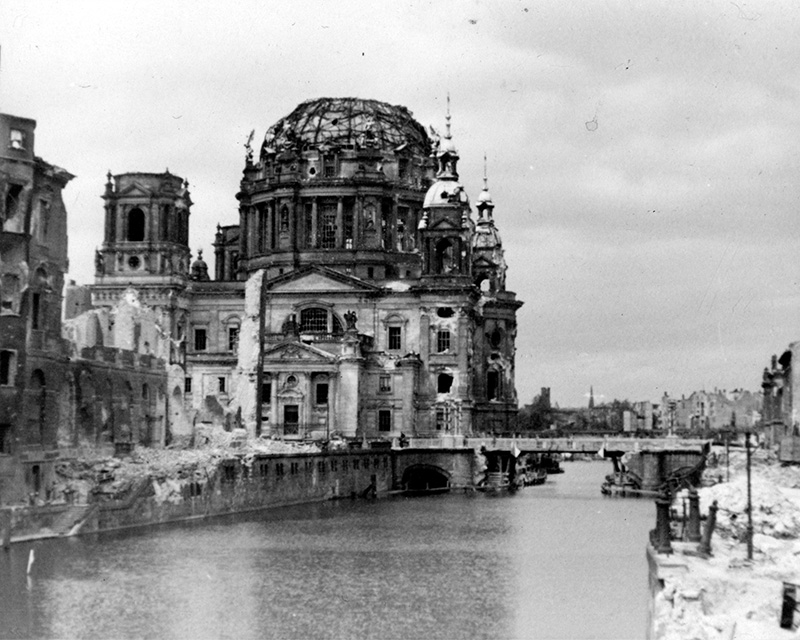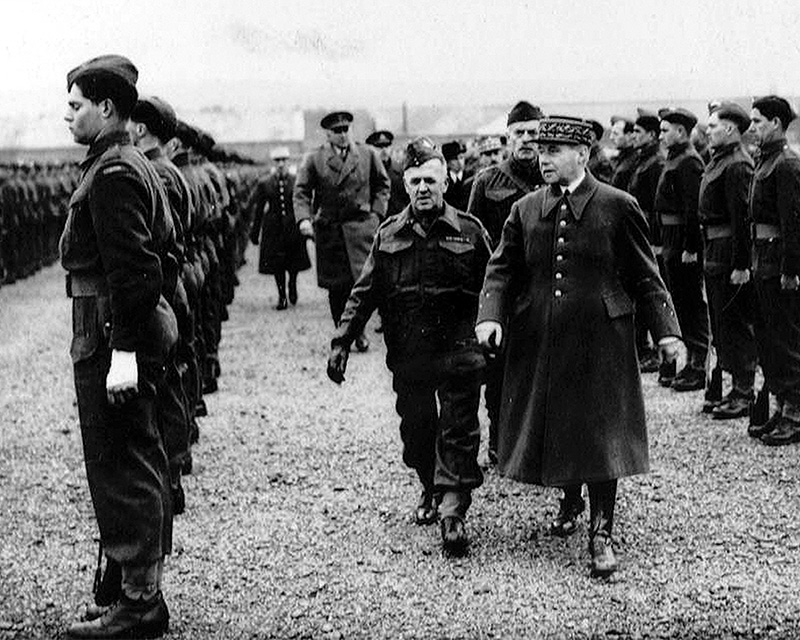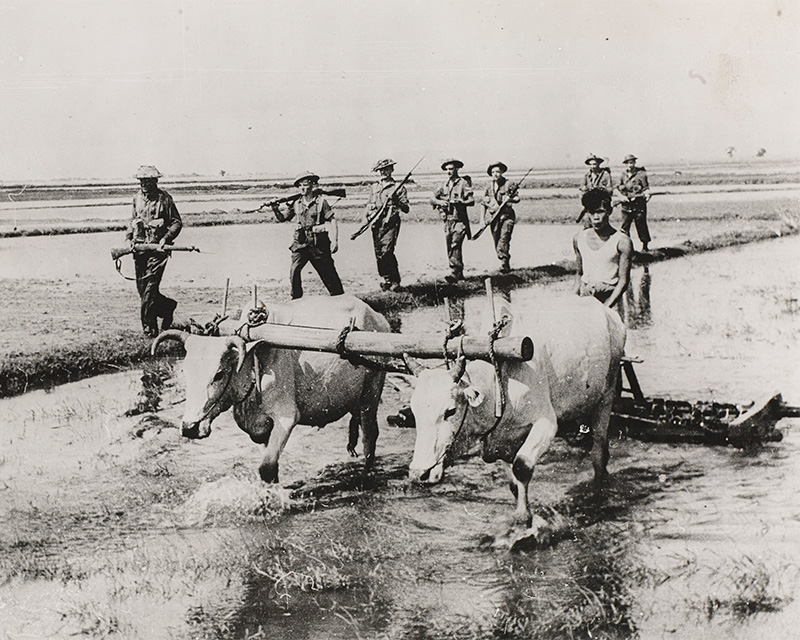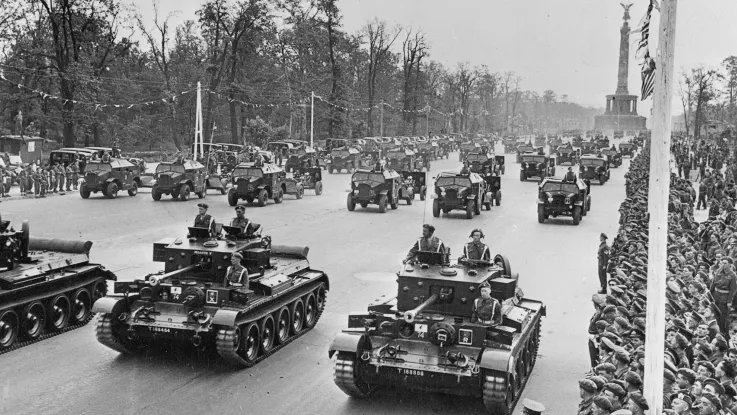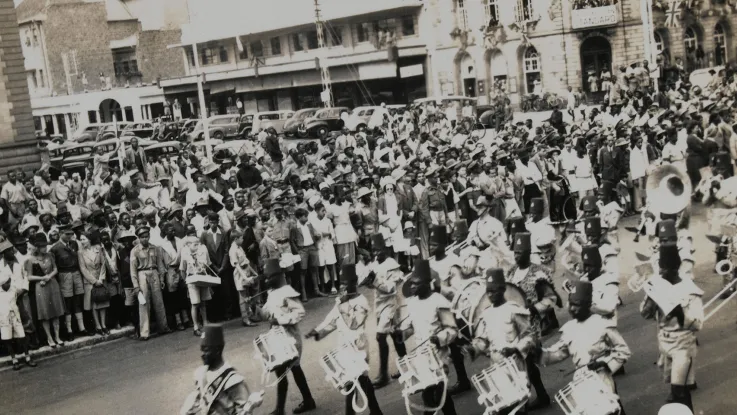
State of affairs
At the beginning of July 1945, British troops were allowed into Berlin for the first time as the foundations of the Allied occupation of Germany were put in place. Across Europe, British soldiers took part in efforts to reestablish order and prepare for new democratic administrations to take power.
There was a new government in Britain too. On 5 July, the UK held its first general election for a decade, with British soldiers across the world among those casting their ballots. The logistical challenge of counting all their votes delayed the results for several weeks. It was only on 26 July that news broke of a shock landslide for Clement Attlee’s Labour Party. After years of wartime sacrifices, British soldiers and civilians had voted in favour of radical reform.
From 17 July to 2 August, the leaders of Britain, the United States and the Soviet Union met in Potsdam, near Berlin, for the final and most important conference of the Second World War. Plans for postwar peace were agreed, including the objectives of the Allied occupation of Germany, the means of reaching final peace settlements for all the defeated Axis nations, and the implementation of major territorial changes in Eastern Europe. In addition, the Allied leaders at Potsdam issued an ultimatum to Japan demanding unconditional surrender.
The talks took place against a foreboding backdrop. On the eve of the conference, the US government had successfully tested the world’s first nuclear weapon. The onset of the atomic age would fundamentally transform the 20th century.
‘A short while ago I had to go out to take a message to its addresses, and I was ‘held up’ by a Nazi – dog. It was an Alsatian, and didn’t seem to like the look of me at all (ditto repeato as far as I was concerned too). He first of all trailed me snarling, and with his hackles up, then got a bit snappy and I picked up a stick and threw it at him, and beat a retreat into a wireless truck. It prowled up and down outside for a while, yelping and snarling, then squatted down waiting for me to come out. I let it wait! And it had less patience than even I’ve got and finally slouched off. As usual, Public Hero No.1 that’s me.’Sergeant Samuel Bates, Royal Signals, Osnabrück, Germany — 1 July 1945
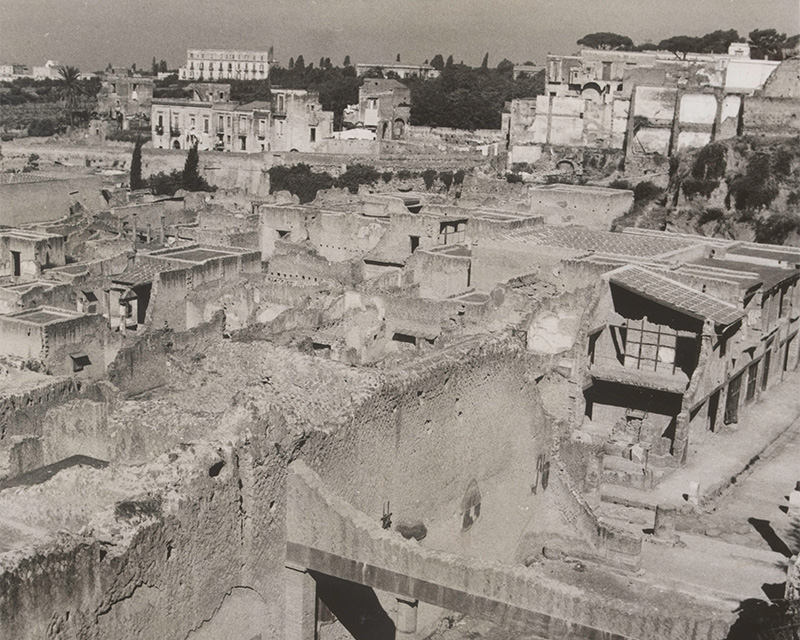
There are ruins, and there are ruins
Frederick Cecil Cracknell of the Army Film and Photographic Unit took pictures of the ancient Roman ruins of Herculaneum in 1945. This historic site held a resonance for visiting British troops stationed in Campania, Italy.
‘1130 Hours: Pitch wickets; 1300-1400 Picnic Lunch; 1600-1630 Buffet Tea; 1830 Draw Stumps. For Your Information: there will be an unlimited supply of lemonade. Ice cream will be served after lunch’Souvenir programme for the British forces Grand Challenge Cricket Match. Curti, Italy — 1 July 1945
Berlin
In July 1945, British troops were finally permitted to enter Berlin. The city was divided between the four occupying powers – Britain, the Soviet Union, the United States and France – but located deep inside the Soviet zone of occupation.
At this time, despite the need to travel through Soviet-controlled territory to reach the city, the Allies did not make any firm agreements over access arrangements to the German capital.
‘Cossack horsemen, cavorting in the early morning drizzle and shouting their traditional war cries, gave us a rousing welcome. We entered Berlin with warm hearts after a journey which began at dawn. In a few hours now the full occupation of the silent capital by the victorious Powers will have begun.’War correspondent Edwin Tetlow accompanying British troops into Berlin — 3 July 1945
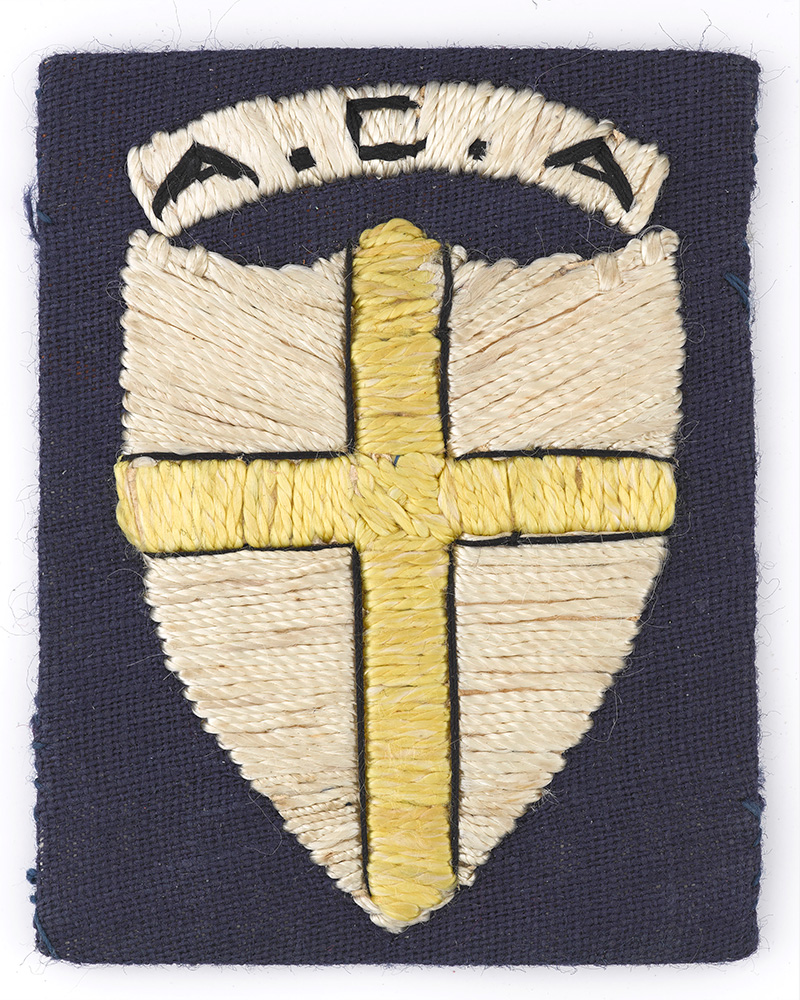
Allied Commission for Austria
On 4 July, the Allied Commission for Austria (ACA) was established. Its formation badge can be seen above.
The ACA was intended to govern Austria as part of a four-power military occupation, with the British, French, Americans and Soviets each governing a different zone of the country.
‘Passing over Friendship Bridge at MAGDEBURG the column swung North through the Russian lines and thence along the Autobahn axis towards the Capital. It reached the outskirts late in the evening and drove in parade past Major-General L. O. Lyne, Commander, British Troops, BERLIN to its Billet areas in the North of the City. The Billets allotted to the Battalion were in WEDDING in the former HERMANN GOERING BARRACKS’War diary of 1st Battalion, Grenadier Guards, Berlin, Germany — 4 July 1945
Canadian riot in Aldershot
4-5 July 1945
For much of the Second World War, Aldershot hosted a large number of Canadian troops (pictured above during an inspection in 1939). By the end of the conflict, around 30,000 remained in the Hampshire town awaiting either a return home or redeployment to the Pacific.
On 4 July, rumours spread that Canadian soldiers had been imprisoned in the local police station, prompting several hundred men to march on the town centre. The crowd dispersed after receiving assurances that no Canadians were being held. But the following night, a full-scale riot broke out, with Canadian troops causing £10,000 of damage to shops and buildings.
The incident resulted in 100 soldiers being court-martialled and revealed the growing impatience with the demobilisation process among troops of all Allied nations.
‘It is beginning to get much colder now and the decks are not as full in the night and early morning. Picture show during the evening. It was ‘English Without Tears’, which I have already seen, but I enjoyed seeing it again in spite of the fact that it had been cut to hell. Last ration of cigarettes and chocolate today.’Signalman Walter Shearer, Royal Signals, on a ship home to the UK from Burma — 4 July 1945
General election
5 July 1945
As the UK went to the polls, great efforts were made to ensure that service personnel stationed across the globe could cast their vote. This poster, designed by Abram Games, was an attempt to encourage participation among the troops.
The delay in bringing overseas votes back to Britain meant that the election results would only be revealed on 26 July.
Sheikh Bashir Rebellion
In early July 1945, religious leader Sheikh Bashir led an uprising of the Habr Je’lo clan in British Somaliland (now Somaliland, a de facto independent state internationally recognised as part of Somalia). Anti-colonial protests had erupted here intermittently ever since Britain colonised this part of East Africa in the 19th century.
The 1945 revolt, which broke out in the city of Burao, prompted a military counteroffensive in which British, Indian and South African troops tracked down and killed Sheikh Bashir, effectively ending the rebellion on 7 July.
British Somaliland remained an imperial protectorate until it gained independence in 1960.
Final skirmishes in Burma
After conquering most of Burma (now Myanmar), British forces remained on guard. Above, a British patrol is pictured in the countryside east of Waw.
In the first half of July, stranded Japanese forces staged several minor counterattacks to support a general withdrawal. In monsoon conditions, this attempted breakout was a military disaster.
‘It was interesting seeing the places again which before had been in the battle area. Now things were coming back to life. At intervals we met caravans of ten to a dozen bullock carts carrying goods from one place to another. Travelling in bands as a protection against the dacoits [bandits] who have now acquired firearms, they take things easily. Starting before dawn they pull into the shade at about 10 o’clock to cook their curry and take a siesta while the bullocks graze. In the villages there are more people about and the gaily coloured silks and homespuns are coming back.’Captain Peter Gallup, Air Photo Intelligence, describing the Grand Trunk Road between Pegu (now Bago) and Taunggyi, Burma — 8 July 1945
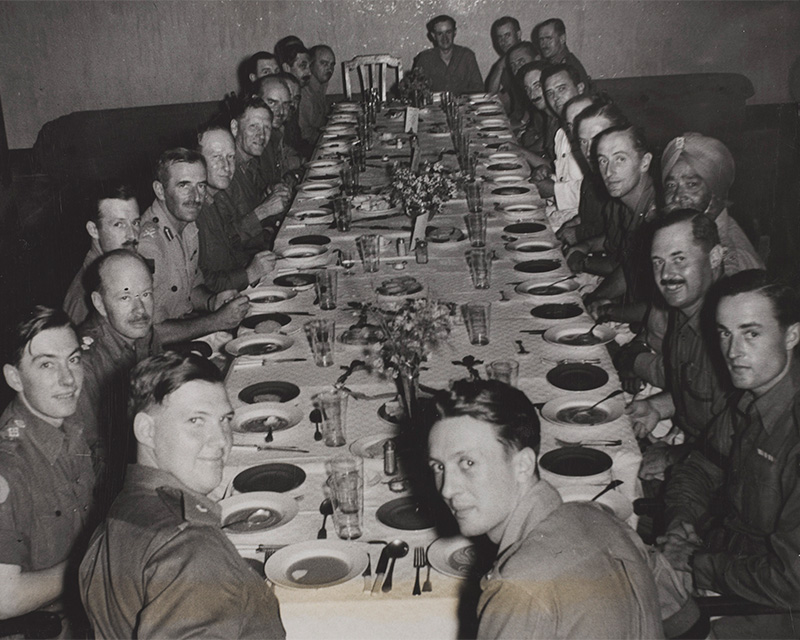
Plans for a final attack on Japan
By mid-July, meaningful peace negotiations with Japan were yet to begin, and the Allies were turning their attention towards the next campaign in the war in Asia.
The 23rd Indian Division (pictured during a visit from General Sir Claude Auchinleck, their commander-in-chief) had returned to India – along with other elements of the Fourteenth Army – in preparation for further action. It was now expected to take part in Operation Zipper, a landing on the west coast of Malaya (now Malaysia).
Meanwhile, American forces began to prepare for an invasion of the Japanese mainland, codenamed Operation Downfall.
‘It seems clear that the anti-fraternization policy will inevitably be modified under what may be described as biological pressure, if under no other.’'The Times' reporting on the ongoing non-fraternisation scandal in occupied Germany — July 1945
Non-fraternisation rules relaxed again
The number of court-martial cases brought against British troops for flouting the ban on contact with Germans continued to rise. This further intensified the controversy over non-fraternisation rules.
On 14 July, Field Marshal Montgomery decided to relax the restrictions once again and allow conversations between British soldiers and adult Germans in public spaces.

Learning the Lingo
Pictured above is a German-English business and commerce phrasebook bought and used by Major Fitton of the Control Commission for Germany.
Trinity nuclear test
On 16 July, the first successful test of a plutonium bomb took place in New Mexico, USA. It was carried out as part of the Manhattan Project, a US-led effort to develop nuclear weapons under the direction of J Robert Oppenheimer.
The Trinity nuclear test marks the beginning of the atomic age.
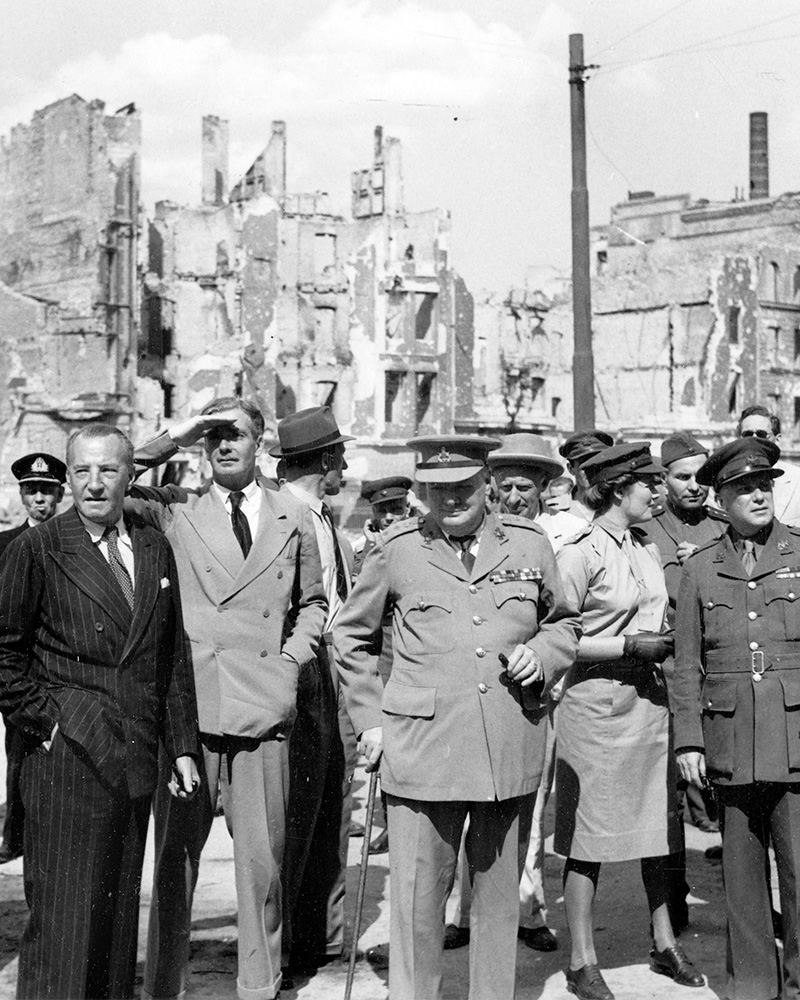
Potsdam Conference
From 17 July, representatives of Britain, the United States and the Soviet Union met to finalise their plans for postwar peace. The conference was held at the Cecilienhof Palace in Potsdam, on the outskirts of Berlin.
Above, Prime Minister Winston Churchill is pictured upon his arrival in Germany.
The Big Three at Potsdam: Churchill, Truman and Stalin
President Harry S Truman attended the Potsdam Conference on behalf of the United States. Truman had been vice-president under Franklin D Roosevelt, and was sworn in as president on Roosevelt's death in April 1945.
With the outcome of the UK general election still undecided, Clement Attlee – the leader of the opposition – took part in the proceedings alongside the incumbent British prime minister, Winston Churchill.
Discussions were strained and news of the successful US nuclear test only intensified existing divisions between the wartime allies.
‘A Barber. A soldier-barber is in attendance on Monday, Tuesday, Thursday and Friday of each week from 6 to 8 p.m. in the Men’s Cloakroom, First Floor, No. 43 Ring Strasse. Price of hair cut will be 2 marks. The style of haircut may however be rather a military one.’List of official amenities for Potsdam Conference delegates — July 1945

British victory parade, Berlin
21 July 1945
With the top brass of the British government and armed forces in Berlin for the Potsdam Conference, the British Army held a victory parade in the German capital. Large crowds flocked to see the soldiers and armour passing through the Tiergarten in the city centre.
British soldiers are pictured above in front of the Siegessäule, a historic Prussian victory column.
Freedom of the city
On 22 July, with the black market rampant across the whole of Germany, the Allied Control Commission agreed that military police forces of the four occupying nations could move freely across the whole of Berlin to combat smugglers and racketeers.
In many cases, British and other Allied soldiers were themselves implicated in illegal black-market activities.
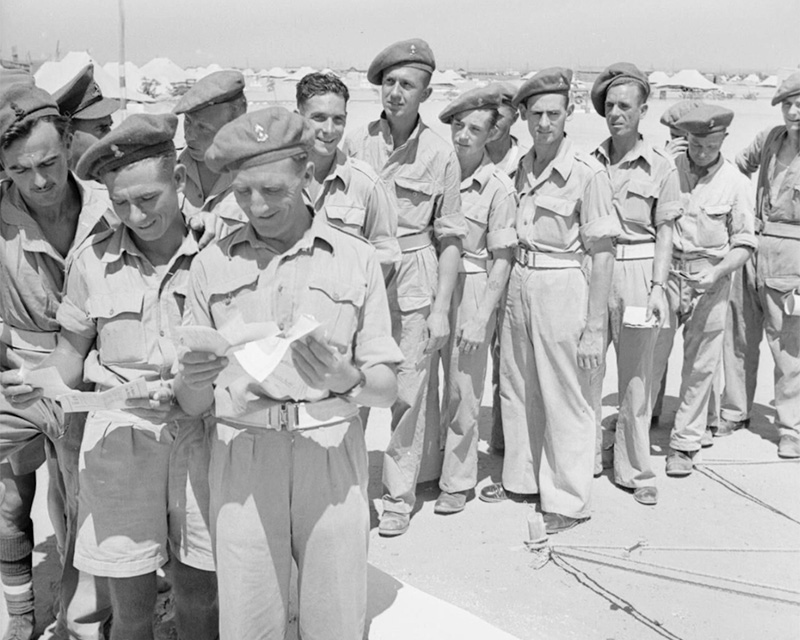
Image: IWM (E 31089)
Landslide victory for the Labour Party
26 July 1945
The Potsdam Conference was temporarily suspended on 25 July in anticipation of the UK general election results. Royal Artillery gunners stationed in Cairo can be seen above preparing to cast their ballots.
The following day, an overwhelming victory for Clement Attlee’s Labour Party was announced. This illustrated the mood of the nation, and of a large majority of the country’s soldiers. After years of wartime sacrifices, there was a demand for radical social change.
The outcome of the election signalled the beginning of the ‘postwar consensus’ in domestic politics, ushering in the creation of the National Health Service, the nationalisation of key industries, and a major expansion of the welfare state.
After the results were announced, Attlee and his foreign secretary, Ernest Bevin, returned to Potsdam as Britain’s leading representatives in negotiations over the European peace settlement.
Terms issued for Japan’s surrender
On 26 July, amid the proceedings at Potsdam, the Allies jointly issued a declaration of proposed peace terms to Japan. It demanded unconditional surrender and the acceptance of an Allied military occupation of the Japanese mainland.
The ultimatum stated that if Japan did not comply, it would face ‘prompt and utter destruction’.
‘I get a fair amount of “back door gossip” from my ATS as to the characters & peculiarities of the various delegates. Stalin was most popular when he came to dinner with Churchill, partly because he waved to each of the ATS […] There is general depression now since the election results but Attlee is awfully popular with all who know him. […] The ATS had some Russian girls along to the garden party we had, & they were a great success. Two of them were snipers & had the Stalingrad medal as well as one for bravery. Mary Churchill also came along & the Scots Guards (band!) played in the garden.’Junior Commander Margot Marshall, Auxiliary Territorial Service, writing to her mother from Berlin, Germany — 29 July 1945
Liverpool FC tour the British Zone
At the end of July, Liverpool FC became the first of a series of professional football clubs to tour the British occupation zone in Germany. These games were intended to provide entertainment for British soldiers awaiting demobilisation.
With so many professional players in army ranks, the professional teams often struggled. Liverpool drew 3-3 with an Army XI in Hanover. The Liverpool team included Billy Liddell, the fifth-highest goalscorer in the club's history.
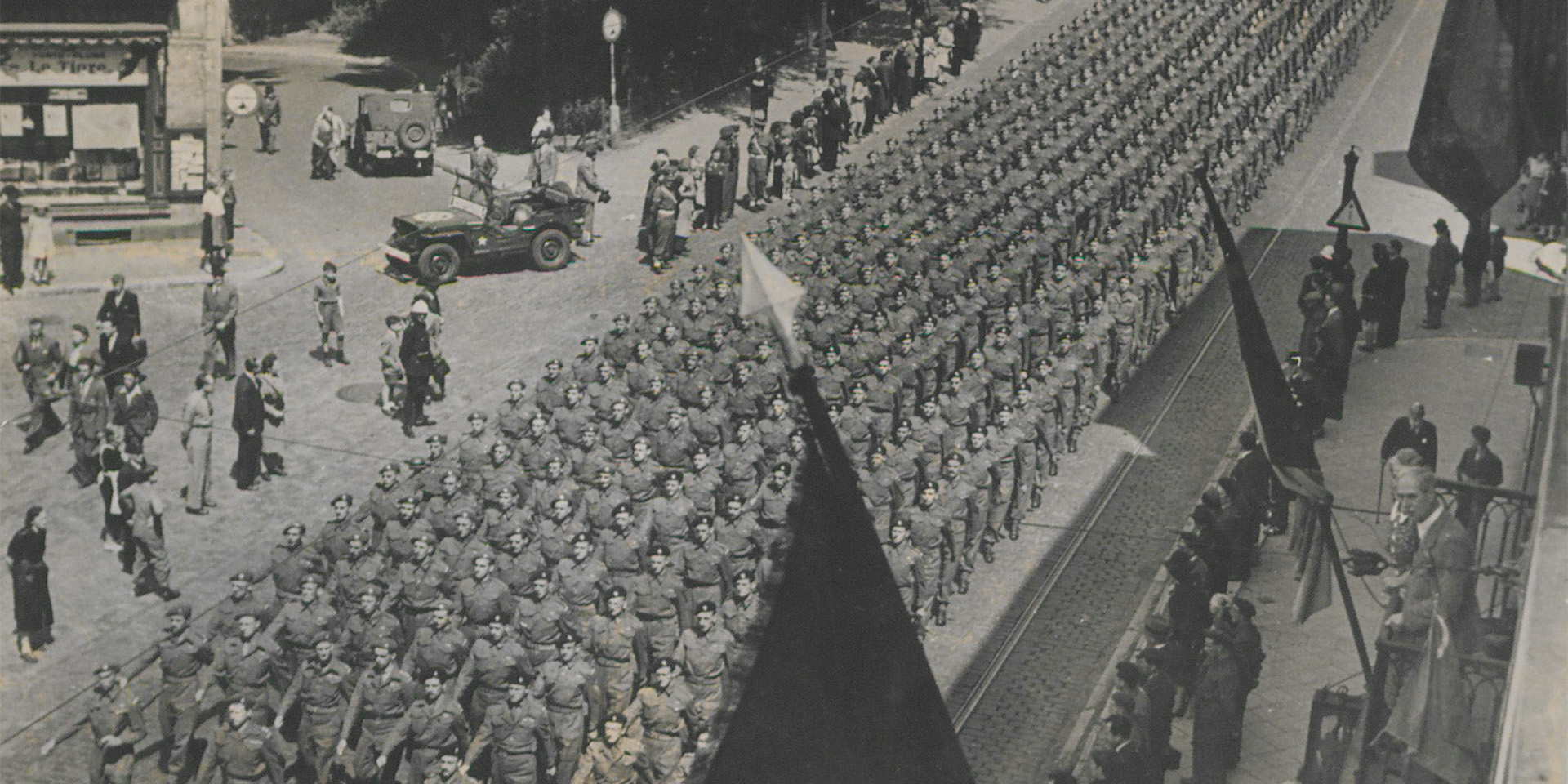
Allied victory parade, Brussels
On 28 July, the British Army took part in a victory parade in Brussels. After its liberation, the Belgian capital became a nexus of British Army logistics in Europe and an important rest centre for Allied troops.
In a show of gratitude to their liberators – or perhaps simply for some much-needed entertainment – huge crowds of local civilians came to watch the parade.
On This Day: 1945
This is the seventh instalment of a series exploring the British Army's role in 1945 – one of the most decisive years in modern history – drawing upon the National Army Museum's vast collection of objects, photographs and personal testimonies.
Throughout 2025, a new instalment will be released each month that focuses on events from 80 years beforehand. The series will highlight the everyday experiences of Britain’s soldiers alongside events of grand historical significance.


